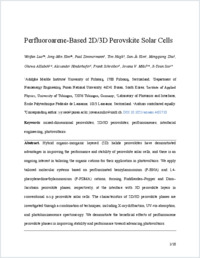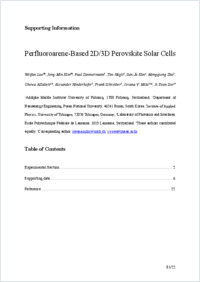Perfluoroarene-Based 2D/3D Perovskite Solar Cells
DOKPE
- Weifan , Luo University of Fribourg
- Jong-Min, Kim Pusan National University, Busan, South Korea
- Paul, Zimmermann University of Tübingen, Germany
- Tim, Hügli University of Fribourg
- Sun-Ju, Kim Pusan National University, Busan, South Korea
- Mengqiong, Zhu University of Fribourg
- Ghewa, AlSabeh University of Fribourg
- Alexander, Hinderhofer University of Tübingen, Germany
- Frank, Schreiber University of Tübingen, Germany
- Jovana, Milic ORCID University of Fribourg
- Ji-Youn, Seo Pusan National University, Busan, South Korea
- 2025
Submitted to:
- ACS Applied Energy Materials. - Washington, D.C., USA: American Chemical Society (ACS). - 2025, p. 1-40
mixed-dimensional perovskites
2D/3D perovskites
perfluoroarenes
interfacial engineering
photovoltaics
English
Hybrid organic-inorganic layered (2D) halide perovskites have demonstrated advantages in improving the performance and stability of perovskite solar cells, and there is an ongoing interest in tailoring the organic cations for their application in photovoltaics. We apply tailored molecular systems based on perfluorinated benzylammonium (F-BNA) and 1,4- phenylenedimethylammonium (F-PDMA) cations, forming Ruddlesden–Popper and Dion– Jacobson perovskite phases, respectively, at the interface with 3D perovskite layers in conventional n-i-p perovskite solar cells. The characteristics of 2D/3D perovskite phases are investigated through a combination of techniques, including X-ray diffraction, UV-vis absorption, and photoluminescence spectroscopy. We demonstrate the beneficial effects of perfluoroarene perovskite phases in improving stability and performance toward advancing photovoltaics.
- Faculty
- Faculté des sciences et de médecine
- Department
- AMI - Physique de la matière molle
- Language
-
- English
- Classification
- Physics
- Other electronic version
- License
- Open access status
- green
- Identifiers
-
- DOI 10.1021/acsaem.4c01710
- ISSN 2574-0962
- Persistent URL
- https://folia.unifr.ch/unifr/documents/332251
Other files
Statistics
Document views: 55
File downloads:
- ae-2024-01710q: 90
- ae-2024-01710q_si: 39

